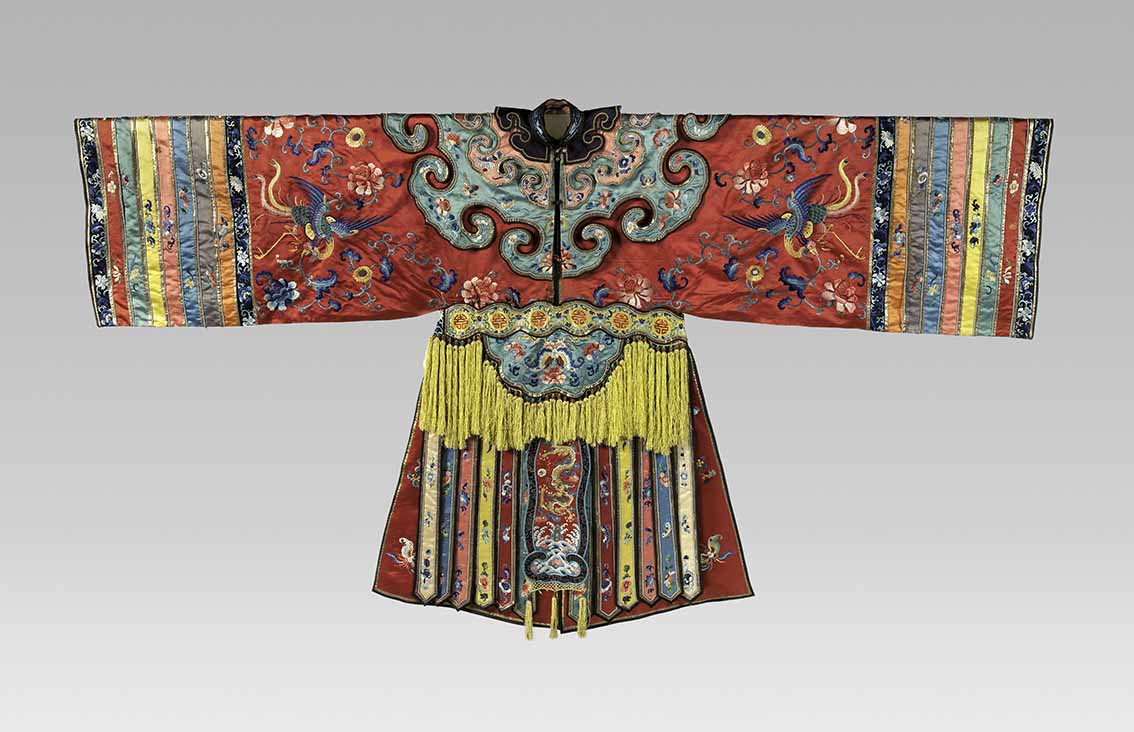This is a colourful and festive exhibition of Chinese opera costumes with more levels of depth than a gold mine because what one sees on the surface is only just the beginning. Kudos goes out to the Met’s curators for cobbling this spectacle together and to Sir Joseph Hotung for underwriting it.
A Westerner’s reaction to his or her first visit to a performance of Peking Opera is a mix of bewilderment and surprise – wildly colourful costumes, cacophonous music, blaring musical accompaniment, sometimes grotesque face markings, exaggerated movements, brief dialogues, pregnant pauses, acrobatics and dance.
On the other hand, it is no more puzzling than how a Chinese opera goer would react to his or her first attendance at an American rock opera about Paul Bunyan. The only thing that they have in common is that they are both bigger than life.
The Art of Peking Opera – The First Performance
Peking Opera, divided between male roles (sheng) and female roles (dan), is rife with emotional and cultural innuendos as well as both stock and historical characters. It is almost impossible to know the players without a checklist and equally so to know the story without understanding the play.
This is where the Met shows its mettle. Fortunately, the Met, using Chinese opera costumes from its own collection, has come to the public’s rescue to begin a careful explanation of this relatively new to the West, but a fully incorporated aspect of the traditional Chinese arts.
The very first performance of the opera form now known as Peking Opera only took place in 1790 when four opera troupes from Anhui arrived in the Forbidden City to perform as part of Qianlong’s 80th birthday celebrations. It very quickly became highly popular with all levels of society and, like Japanese kabuki, it was a male domain. That remained so in China until the 1870s.
Eight Costumes in the Exhibition
The exhibition of Chinese opera costumes is not a large one, mainly because of the visual presence the eight costumes occupy. The exhibition displays and explains the costumes, their roles and their interrelationships. There are two basic types of operas: civil plays (wenxi) based on human relationships and martial plays (wuxi) based on action, the martial arts and acrobatics. To lessen any confusion between styles, the first rotation focuses on costumes used in dramas based on historical events and the second features costumes from plays derived from legends and myths.
Musical Instruments in Peking Opera
The musical instruments employed in Peking Opera are, including variations, either percussion or orchestral. The majority of the percussion instruments, such as drums, gongs and cymbals, started life as military signalling devices. The Six Dynasties exhibition, currently on show at the China Institute’s new location in Lower Manhattan (until 19 March 2017), explains that the transformation of martial signal devices into musical instruments began during that period. The orchestral instruments, however, are more ancient and are mainly the stringed and reed categories of various types.
This exhibition of Chinese opera costumes is organised in two rotations. The presentation will showcase eight robes, each of which was created for a specific role – court lady, official, general, monk, nun, and immortal and to put these into perspective, the exhibition also displays a set of album leaves depicting theatrical characters wearing such robes, as well as a Kangxi yen-yen vase decorated in famille-verte enamels with historical warriors on horseback.
Plays Performed in the Qing Dynasty
Many of the plays performed during the Qing dynasty are no longer performed because many of them consist of more than 24 acts and would take over a week to perform. One such epic play, Shengpingbaofa
(The Precious Raft of Exalted Peace), based on the great classic, Journey to the West, had no less than 240 acts.
One noticeably distinguishing characteristic of leading roles is the use of dramatically painted faces (jing) in Peking chou Opera. Other roles are sheng, dan, jing, and mo. However, face painting is not a characteristic of sheng. Even though there are 15 basic facial patterns, there are over 1,000 variations, just to heap complexity onto complexity. This should give no one pause because it is a continuation of the opening of cultural doors and subtleties within this entire field of opera.
Main Characters in Peking Opera
Even though they are not represented in the exhibition by specific designation, some of the main characters in Peking Opera are Xiao Qiao, a demure, elegant and loyal wife of the general Zhou Yu (175-210), known for his loyalty to the rulers of the Wu Kingdom (182-252); Cao Cao, an evil warlord during the Three Kingdoms period (220-280), who wears the most dramatic Chinese opera costume of all of the sheng roles; and Sun Shangxiang, sister of the Emperor Da of the Wu Kingdom, a formidable woman warrior and, again, wearing the most elaborate costume of all the dan roles, replete with battle armour with flags, a seven-star diadem and two great, long golden pheasant tails to heighten the drama of her postures.
BY MARTIN BARNES LORBER
From the Imperial Theater: Chinese Opera Costumes from the 18th and 19th Century, at the Metropolitan Museum of Art, 25 June 2016 to 9 October, 2017




